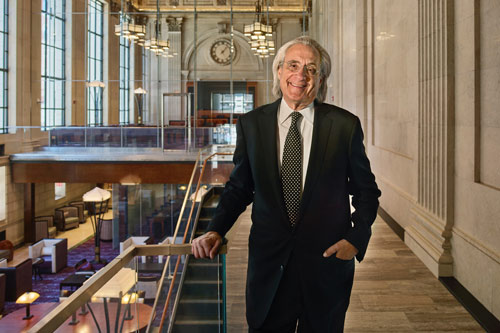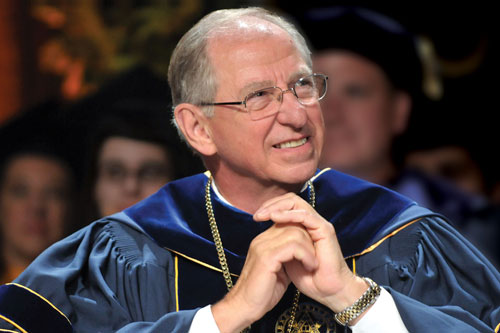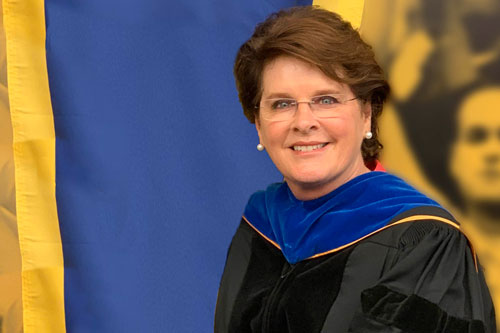At the same time, we have all worked hard for many months to ensure Drexel’s excellence. It has been a period of intense challenge. But we have tackled each challenge in turn, and it could even be said that we have been inspired by them.
Facing a virtually unprecedented situation in our College of Medicine, in addition to a national decline in graduate and international student enrollment, we took difficult steps necessary to close a significant budget gap. As a result, the new academic year began on a solid financial footing, a tribute to the resolve and resilience of this community.
We also expanded our partnership with Tower Health, resulting in our joint purchase of St. Christopher’s Hospital for Children, a venerable institution that was caught up in the bankruptcy of Hahnemann University Hospital. Our operation of St. Christopher’s has returned the hospital to the fold of nonprofit institutions in the city, safeguarded our access to clinical training sites for our third- and fourth-year medical students, and ensures the continuing high-quality care for children in one of Philadelphia’s most vulnerable neighborhoods.
Drexel’s alumni and friends expect nothing less of this University, of course. And we know that their support is unwavering — as witnessed by the substantial strides in the latest Campaign for Drexel. The Future Is a Place We Make campaign stands at more than $610 million, including over 125 new endowed scholarship and fellowship funds, 10 endowed professorships, and more than $5 million raised to support global and cultural co-op experiences. More than 1,120 faculty and professional staff also generously donated to Drexel in the most recent fiscal year.
We can be equally proud of our stewardship of the University’s endowment which encompasses $825 million in total assets between Drexel University and the Academy of Natural Sciences. Our returns have been consistently strong, and these funds are helping to aid our academic enterprises, including the student financial aid that keeps a Drexel degree affordable — aid that has grown by approximately $111 million since 2015, while holding down tuition and fee increases. Specifically, the Drexel endowment has had a steady 8.3 percent annual return since its inception nearly three decades ago, and the Academy’s endowment has achieved a 7.5 per cent annual return since December 2011 when the portfolio transitioned to the University after the Academy joined Drexel.
Consistent efforts to moderate Drexel’s tuition, and room and board increases have helped the University improve its cost competitiveness. In fact, Drexel recently improved 64 places in a national ranking of affordability among four-year private nonprofit institutions.
 Thomas R. Kline
Thomas R. Kline
This fall, we welcomed the newest members of the Drexel community, nearly 3,200 in number. They are diverse and talented, with an average SAT score of 1290 — up by more than 10 points over last year, which itself was a watershed. We also passed the 500 mark in our Liberty Scholars program, founded nearly a decade ago by then-Interim President Chuck Pennoni to expand college access for financially disadvantaged students from Philadelphia high schools. Another proud milestone was reaching the fifth anniversary of the Thomas R. Kline School of Law, established with Drexel’s largest-ever naming gift from one of the nation's most accomplished and respected trial lawyers.
Drexel’s newest undergraduates join a vibrant and engaged student body involved in 350-plus student organizations supported by Student Life, and volunteering at hundreds of nonprofits around the region through the Lindy Center for Civic Engagement. On campus, incoming students have found new amenities, including the just-opened Drexel Square, the beautiful public space across from 30th Street Station created by our partner Brandywine Realty Trust, and a renovated Bentley Hall residence that will become the new home for Pennoni Honors College students.
 C.R. "Chuck" Pennoni
C.R. "Chuck" Pennoni
For year-round athletics, we’ve added bubbles at the Buckley Recreational Field and the Vidas Athletic Complex. We just broke ground on a new project that will support both our community partnerships, as well as Drexel students pursuing careers in the education field: a new building for the Samuel Powel Elementary School and the Science Leadership Academy Middle School at 36th and Warren Streets — a project funded entirely by external private and public donations. And in 2020, Wexford Science & Technology will begin construction on an academic tower next door to the school at 36th and Filbert streets to house Drexel’s College of Nursing and Health Professions and key elements of the College of Medicine, integrating those vibrant colleges with the University City campus.
This academic year, we welcomed three deans, two new to campus and one long-time colleague, Penny L. Hammrich, PhD, who transitions to her first full year as dean of the School of Education following a year as interim. New to Drexel is Norma Bouchard, PhD, who becomes dean of the College of Arts and Sciences. She joins us from San Diego State University, where she was dean of the College of Arts and Letters and a professor of European Studies. Dr. Bouchard takes over from Maria T. Schultheis, PhD, who served admirably as interim. Finally, Charles B. Cairns, MD, is the new Annenberg Dean and Senior Vice President of the College of Medicine, succeeding Daniel V. Schidlow, MD, who graciously delayed his planned retirement through the summer months while the College of Medicine strengthened its ties to our academic medicine partner, Tower Health.
We are also filling 31 tenured and tenure-track faculty positions, with hires expected for teaching, clinical and research faculty.
Meanwhile, the College of Medicine is adapting to significant challenges caused by the closure of Hahnemann University Hospital and has worked hard to support its faculty and students. It remains the sixth-largest medical school in the country, receiving more than 14,000 applications each year for 260 spots, with an acceptance rate of 5 percent.
 Dana Dornsife
Dana Dornsife
A commitment to improving health care engages philanthropists Dana and David Dornsife, after whom our Dornsife School College of Public Health is named. As the founder of the Lazarex Cancer Foundation, Dana is working to impact legislation nationally to expand access to cancer trials for low-income individuals, and we are so proud to be partnering with Dana on Community IMPACT, a program that will focus on reducing cancer and improving health outcomes in Philadelphia.
Our research enterprise was elevated to R1 status in the Carnegie Classification of Institutions of Higher Education this year — a rank that denotes the highest level of research activity, held by just 37 private universities around the country. Research expenditures increased to nearly $124 million during fiscal year 2018, up 15 percent over the previous fiscal year. All told, Drexel researchers currently have received more than 600 grants in support of their work, while securing 46 U.S. patents last year. Annually, the University's research activities regularly result in more than 100 invention disclosures. To make sure we maintain the R1 distinction and achieve even more, we’re restructured our research enterprise and are undertaking a comprehensive planning process aimed at better coordinating research support services.
At the Academy of Natural Sciences of Drexel University, we are implementing a new strategic plan with the phased redevelopment of our signature galleries and the creation of exhibitions and programs that not only reposition the Academy as a ‘force for nature,’ but further unlock its relationship with Drexel. The Academy’s science division continued an exceptional run of success this year, with six out of 13 National Science Foundation proposals securing funding. And in yet another exciting move, the Academy plans to launch what will be known as The Environment Collaboratory, to explore solutions to environmental sustainability problems in a joint venture with the College of Engineering and the College of Arts and Sciences.
We can also take pride in the achievements and abilities of the women and men of Drexel Athletics — and in the leadership of a stellar coaching line-up, notably, women’s basketball coach Denise Dillon, who notched her 300th win this year. In the spring, Drexel also partnered with the city of Philadelphia, the Philadelphia Eagles and the NCAA to host the NCAA Men’s Lacrosse Championship for the fourth time. More than 80,000 people spent Memorial Day weekend at Lincoln Financial Field watching the action. The women's squash team finished seventh in the nation last season, the highest ranking in program history, and earned a bid to the Howe Cup ‘A’ Finals at the CSA National Championship. On the men's side, Bransten Ming and Matias Knudsen both earned Second Team All-American honors. Drexel women's basketball player Bailey Greenberg was named the CAA Player of the Year, becoming only the second Drexel athlete to do so. On the men's side, Camren Wynter was named CAA Rookie of the Year.
Finally, with this new academic year, we proudly celebrate a century of co-op at Drexel. The model of education that Drexel has refined over a century is uniquely suited to the modern world. Rapid advances in technology and society are transforming every industry, and America will thrive only by developing talent capable of confronting dynamic change. I am confident that no university is better positioned than Drexel, philosophically and organizationally, to nimbly navigate the vibrations underfoot and ensure that every graduate has the personal resilience and professional competencies to contribute to the work of the future.
That’s why, on so many fronts, we say we are inspired by challenge.
Sincerely,

John Fry
President